Instruments on display
The following is a list of the instruments currently on display at the Faculty of Psychology.
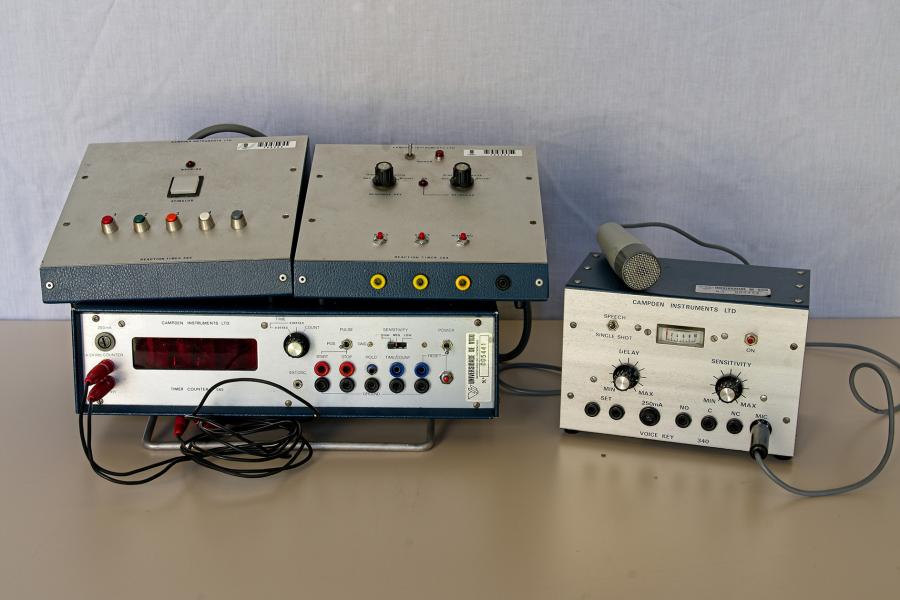
It was acquired in the 80s of the 20th century.
The unit consists of a stimulus presenter that allows the presentation of visual stimuli (four lights of different colours), and four response keys. In addition, it includes a time meter, which allows measuring simple reaction times and choice reaction times.
It also has a vocal key which consists of a unit that is connected to a stopwatch to measure phonic reaction times. It consists of a main body and a microphone that serves as a response key for the subject.
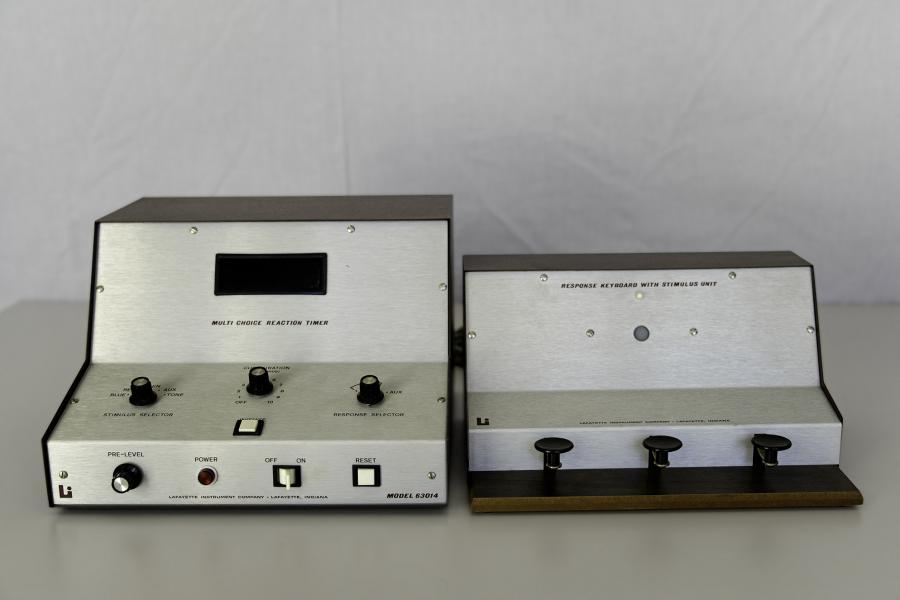
It was acquired in the 80s of the 20th century.
This device is used to measure the response time to visual stimuli (colours). It consists of two units: one for control and the other for stimuli/response. Reaction times are displayed on a 1/1000 second stopwatch located on the control unit.
Subjects can control light intensity (blue, red and green) and also the response key in which each colour will turn off. Before the coloured light appears, another white light turns on for a short period of time, indicating the presentation of the colour.
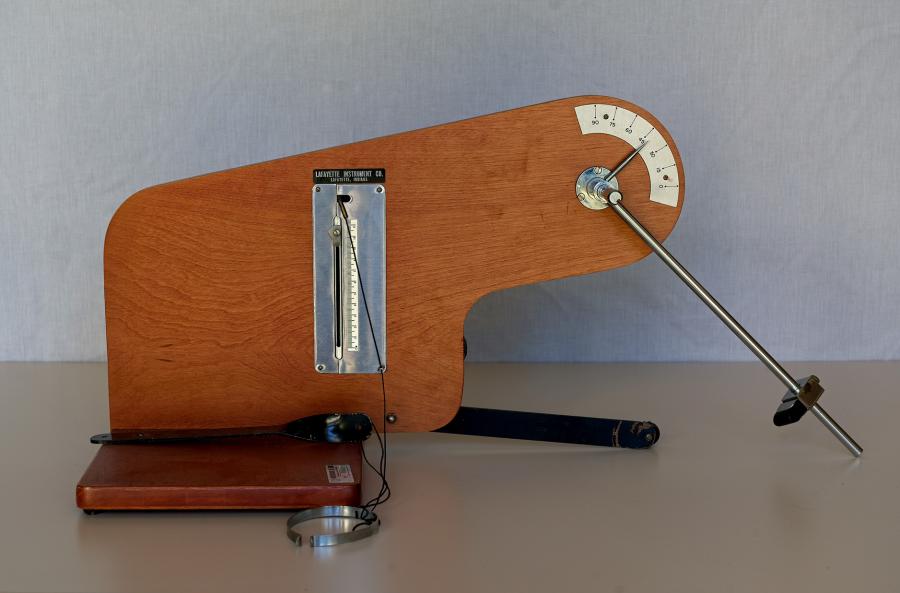
It was acquired in the 80s of the 20th century.
This device not only measures the knee reflex but also the conditioned response to the presentation of a signal, for example, a sound.
The device automatically measures the displacement of the foot between 0 and 10.5 cm. Hammer arm and hammer are adjustable. Includes an indicator to accurately measure the degree of hammer travel.
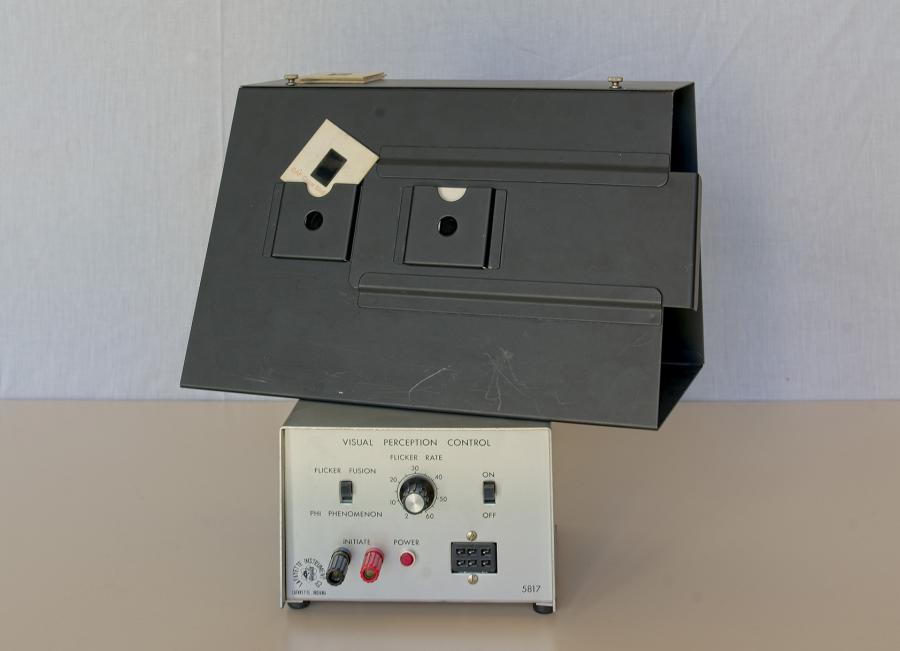
It was acquired in the 80s of the 20th century.
This instrument serves to cause apparent movement. Light movement can be perceived when there is no movement at all (PHI phenomenon). You can also see a static light when there is actually a flicker (critical melting point).
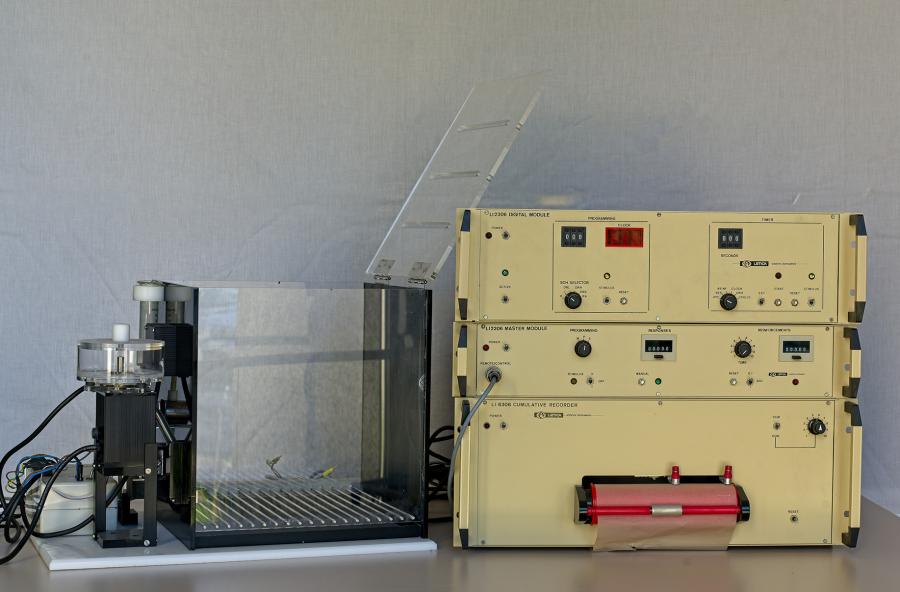
It was acquired in the 80s of the 20th century.
It serves to measure the cumulative record of responses. It is normally used together with the Skinner Box.
The registration is done with two pens: one for the time and another for the information. Writing is done with a fine marker. The device marks each time the animal presses the lever and each time it receives reinforcement. The paper comes out continuously.
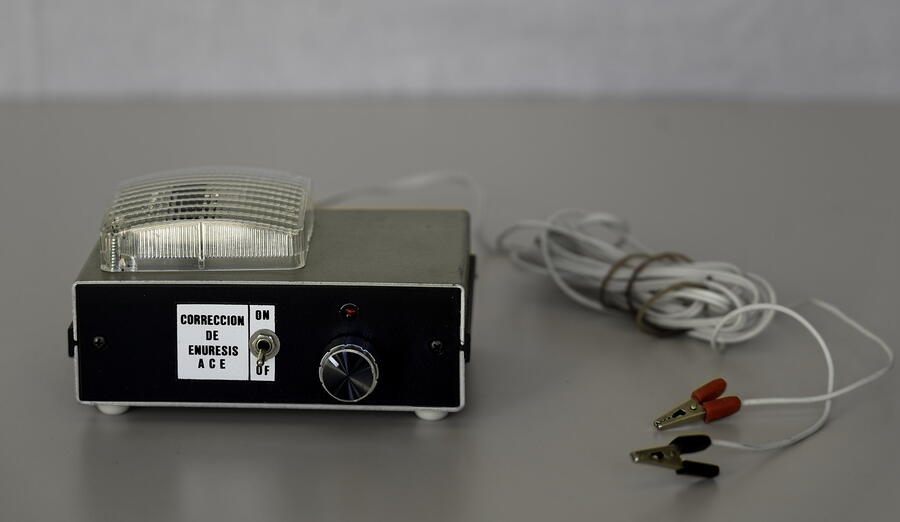
It was acquired in the 80s of the 20th century.
The device for the treatment of enuresis is based on the principles of classical conditioning. It consists of 2 bars (modern ones use a compress) that are placed on the bed, separated by a cloth so that they do not come into contact. When the boy or girl leaks urine, the two bars make contact and an alarm goes off causing the person to wake up and the flow of urine is cut off. After several times, the person wakes up before the alarm goes off.
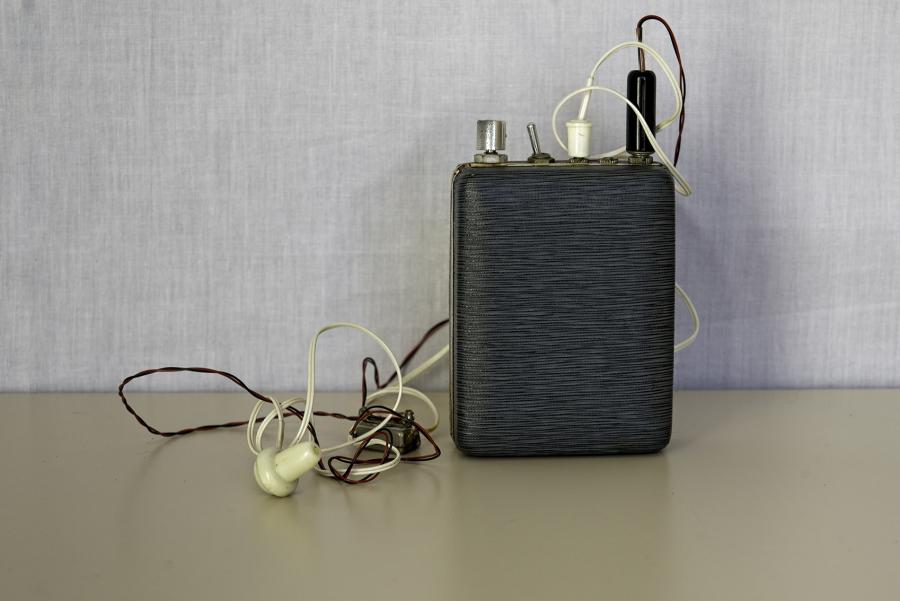
It was acquired in the 80s of the 20th century.
It is an auditory masker based on the principles of behaviour therapy and feedback. It is suitable for both clinical and private use.
It is based on studies indicating that auditory feedback masking produces, in various types of stuttering, a considerable improvement in speech fluency.
Thanks to the microphone, the device produces a variable sound at will. At the moment the subject speaks, the aerial listening circuit is eliminated. The tone is heard with a headset.
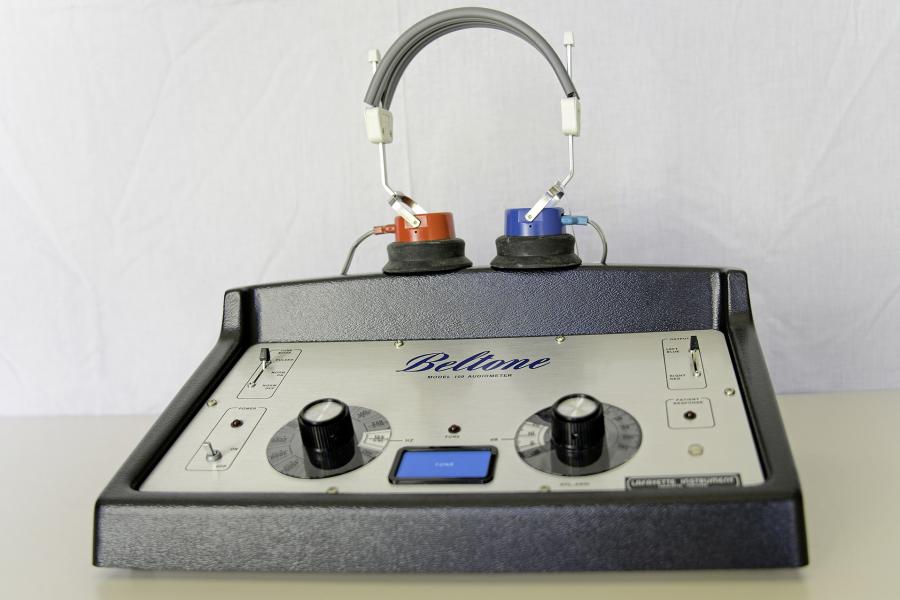
It was acquired in the 80s of the 20th century.
An audiometer is a device designed to produce sounds of unique frequencies, called “pure tones,” which the subject must listen to through headphones.
The device has two earphones that work independently: the red one is for the right ear, and the blue one is for the left ear.
To detect the threshold, you start with a high tone, such as 70 dB (decibels), and lower the sound level (5 at a time) until the individual says that he or she does not hear anything. Subsequently, it is raised (5 at a time) until the subject says that he perceives the sound.
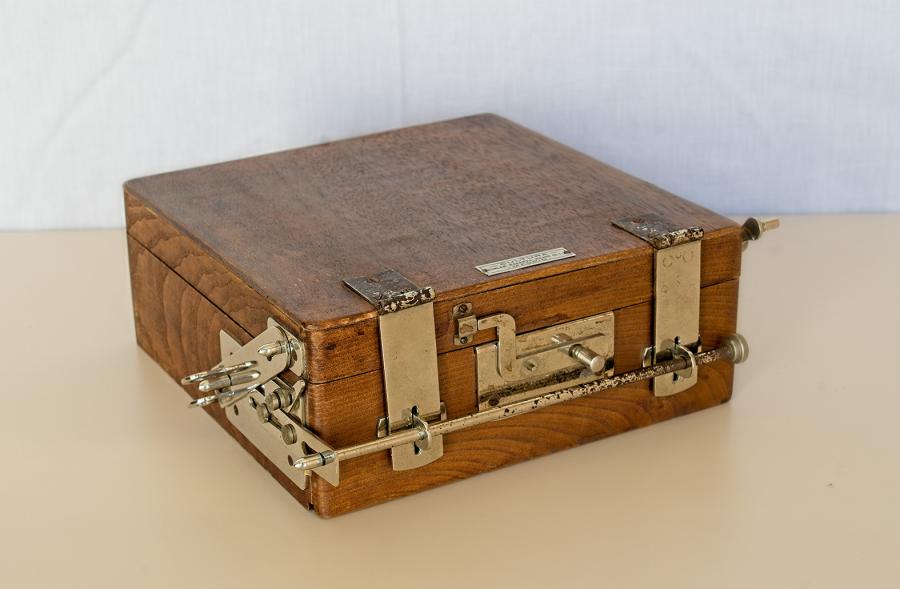
It was probably acquired in the 30s or 40s of the 20th century.
It is a puzzle box that is closed by different mechanisms (locks), all linked together. To open the box, you have to go to the first mechanism and take them all in a row to the end. If you skip any step, or alter the order, the box will not be opened.
It evaluates aspects related to manual aptitude and spatial intelligence, involving reasoning and understanding.
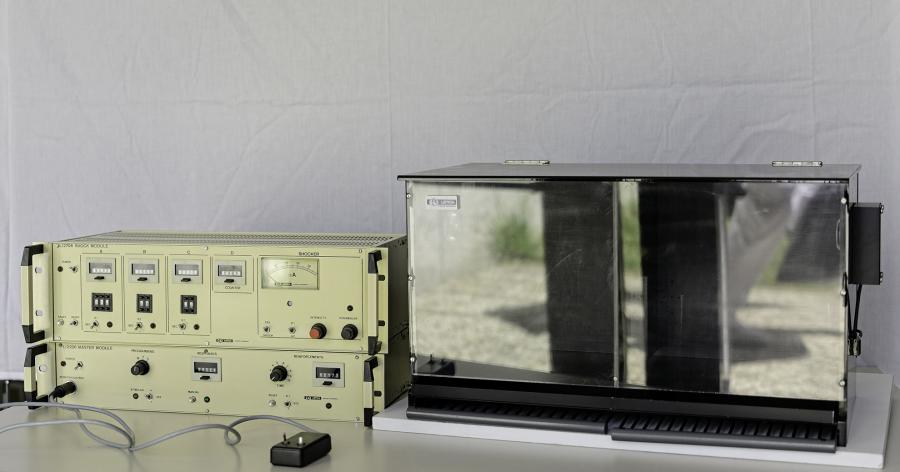
It was acquired in the 80s of the 20th century.
The shuttle box is used in research work on animal behaviour. It is particularly useful for escape or avoidance operant conditioning, since these types of learning require the administration of negative stimuli.
This box has two compartments separated by a low barrier that the animal must jump over to avoid electric shocks.
In addition, it has an attached electroshock generator for the administration of aversive stimuli.
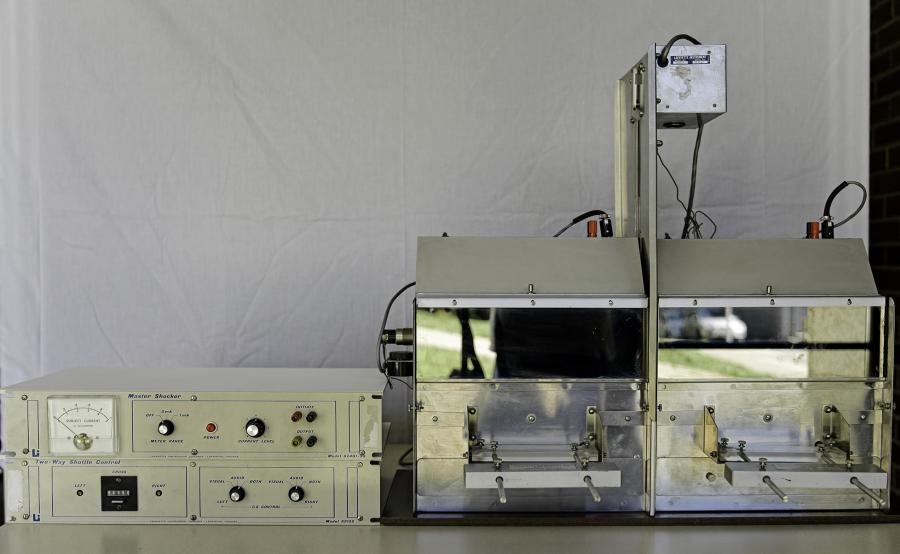
It was acquired in the 80s of the 20th century.
This shuttle box consists of modular units that can be assembled to do avoidance and escape programs in rats and mice. These boxes have two lights on each side, as well as 18 electrified bars on the floor. In the junction of the two modules there is a trapdoor for the rat to jump from one to the other. It has two location sensors and two speakers.
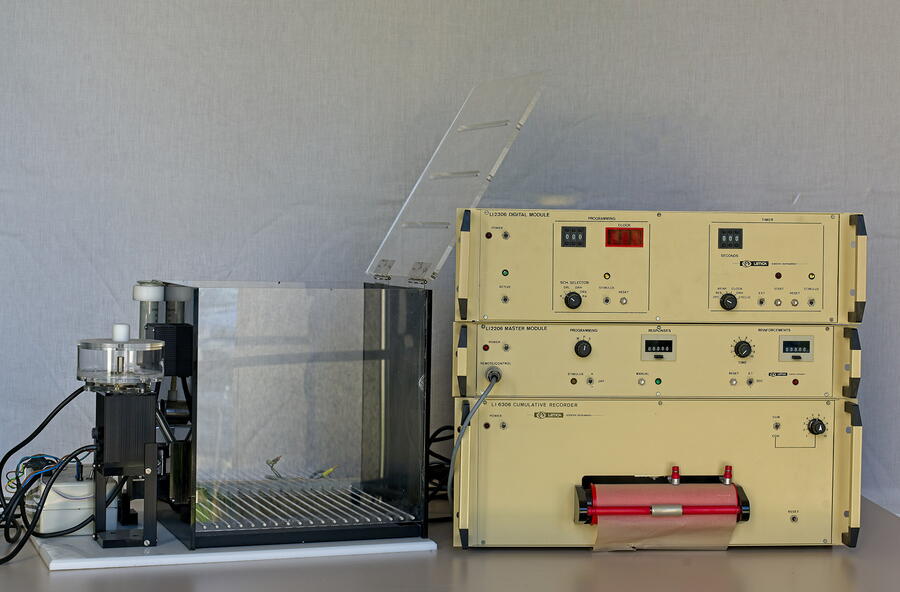
It was acquired in the 80s of the 20th century.
The operant conditioning chamber or Skinner box is named after its creator, Burrhus F. Skinner. It is an instrument with which research on animal learning can be carried out; specifically, on operant conditioning. Its antecedent was the problem boxes of Edward L. Thorndike.
The Skinner box, in its simplest version, has a lever that the animal can press and a device to deliver reinforcement when the lever is pressed. This model has mechanisms that show the animal the availability of reinforcement by means of a light or a sound. It is also equipped with additional devices such as a control module or a cumulative register.
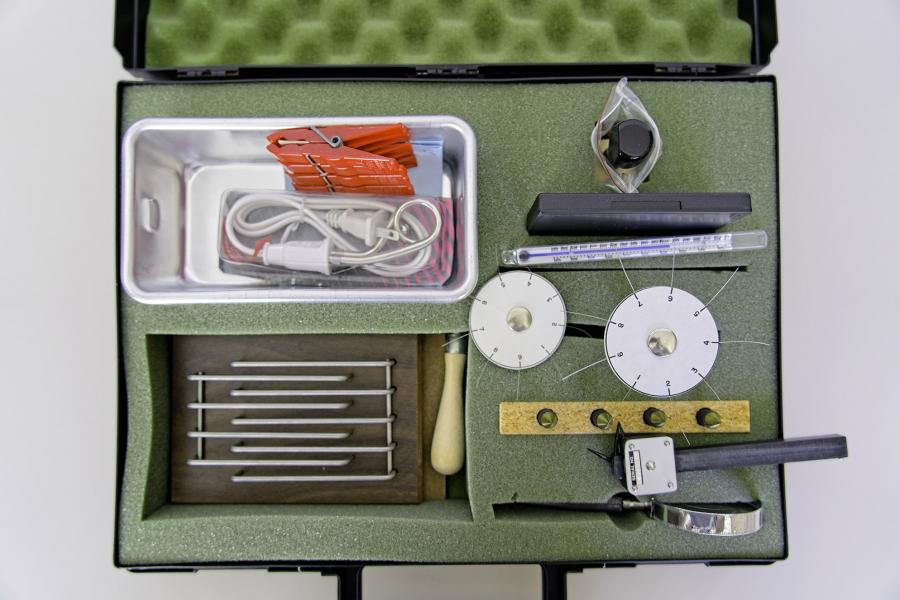
They were acquired in the 90s of the 20th century.
This set of instruments is used for studies on sensitivity related to touch, pressure, cold and heat.
- Touch sensitivity is measured with a von Frey hair esthesiometer. The person (experimental subject) is touched on a part of the body with each of the hairs (silks), starting with the simplest silk and continuing with the thickest one. It ends when the person feels that s/he is being touched.
- Pressure sensitivity is done with the two-pronged esthesiometer. The tips are separated repeatedly while touching the person with them at each separation until s/he feels being touched with two tips at a time, and not only one.
- Sensitivity to cold and heat is carried out by pressing on a part of the body with the tip of the cylinder, and the person has to say if s/he feels cold or hot. Some cylinders are cold (they are cooled with ice) and others are hot (they are heated with hot water). The tweezers are designed so that the experimenter can hold the cylinder without getting burned.
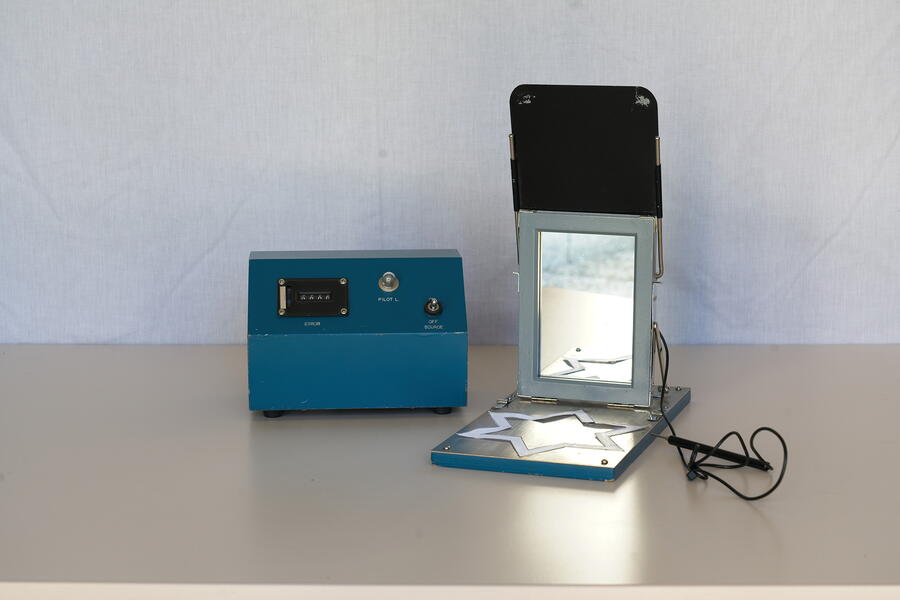
Acquired in the 80s of the 20th century.
This mirror drawing has an electronic controller. The task is to trace over a star with a stylus while looking at the star in the mirror. Every time one leaves the star, the counter counts one error. You can also count the time it takes to trace the star with both your right and left hands.
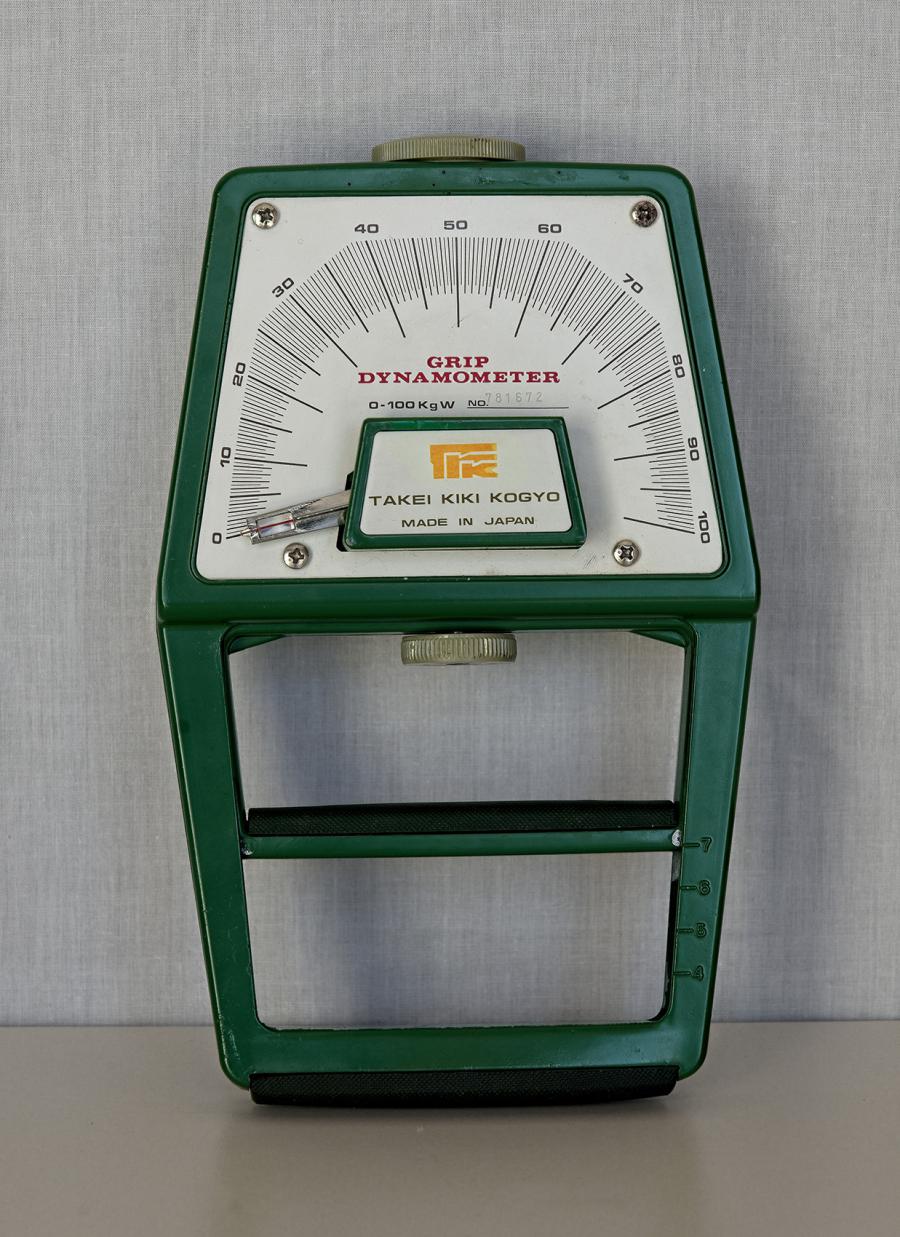
Acquired in the 80s of the 20th century.
The hand dynamometer measures the muscle strength of the hand when trying to close it. The device has a handle that can be adjusted to fit the shape of the hand.
The usual model has a measurement range that is on a graduated scale from 0 to 100 kg/force.
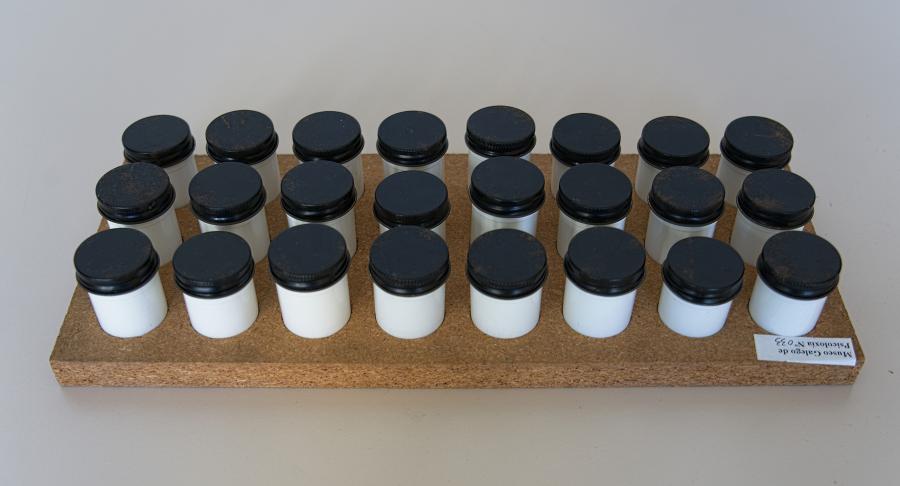
Acquired in the 80s of the 20th century.
This unit is made up of 24 weights. The light series ranges from 75 to 125 g, with differences of 5 g, except for two pieces weighing 100 g. each. The heavy series ranges between 175 and 225 g, with intervals of 5 g, and two weights of 200 g. each. Each weight can be seen in figures written at the bottom of each piece.
The weights are identical in terms of colour, size and material. The unit is used for weight discrimination studies.
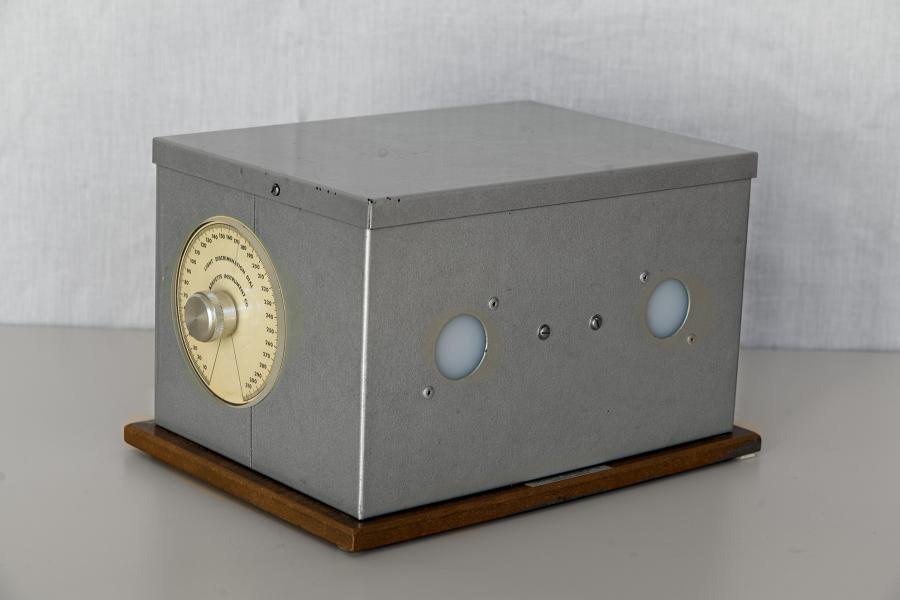
Acquired in the 80s of the 20th century.
The light discrimination testing apparatus was designed to present two light stimuli from a common source.
Each stimulus can be independent of the other through a graduated aperture and with scales located on each side of the unit.
This device is useful for psychophysical or perceptual studies of visual light discrimination. The stimulus can be adjusted by the experimenter or by the subject.
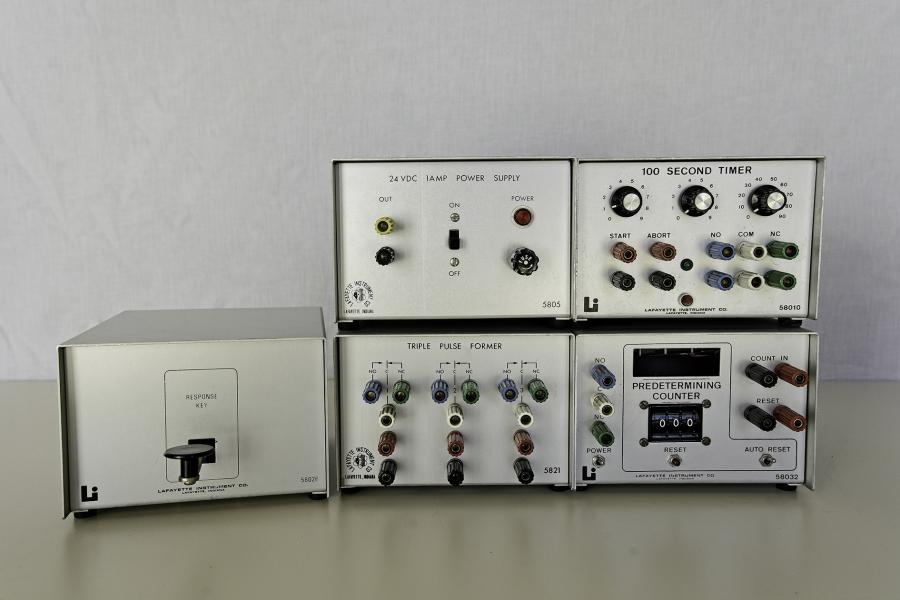
Acquired in the 80s of the 20th century.
The system consists of a series of cubes for programming responses and reinforcements for human learning laboratories. The reinforcement device gives candy or money. The response key is manual and the programmers are four cubes that can program time, intervals and stimuli repetitions.
The main reinforcement schedules are: fixed interval, variable interval, fixed ratio and variable ratio.
The device consists of 4 cubes, an answer key, and a dispenser (this is missing from the device stored in the museum).
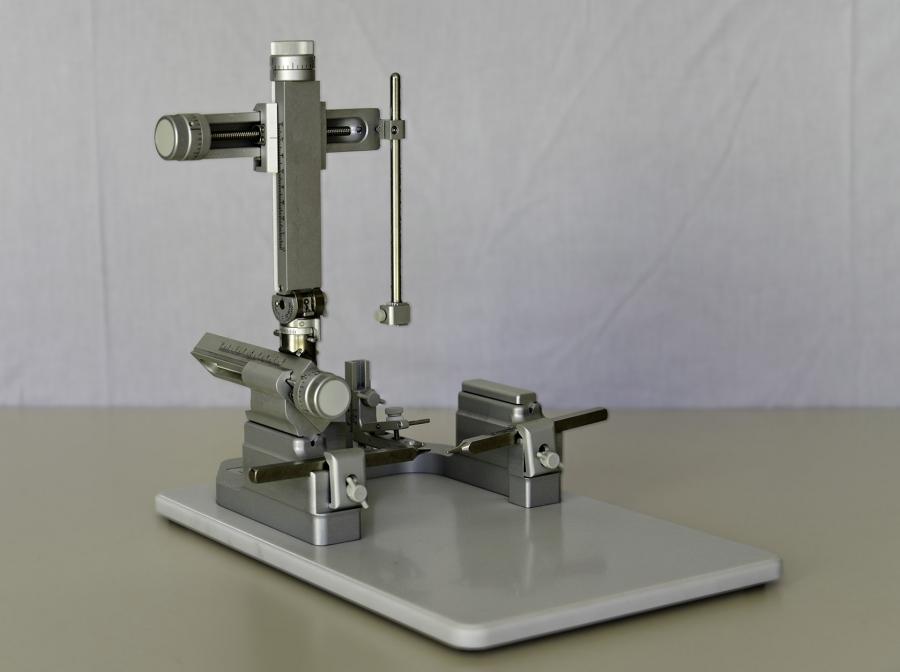
Acquired in the 90s of the 20th century.
Stereotaxic surgery is used in animal research. With this device, drugs can be introduced into specific points in the brain (through surgery) to see the behaviour of the rats.
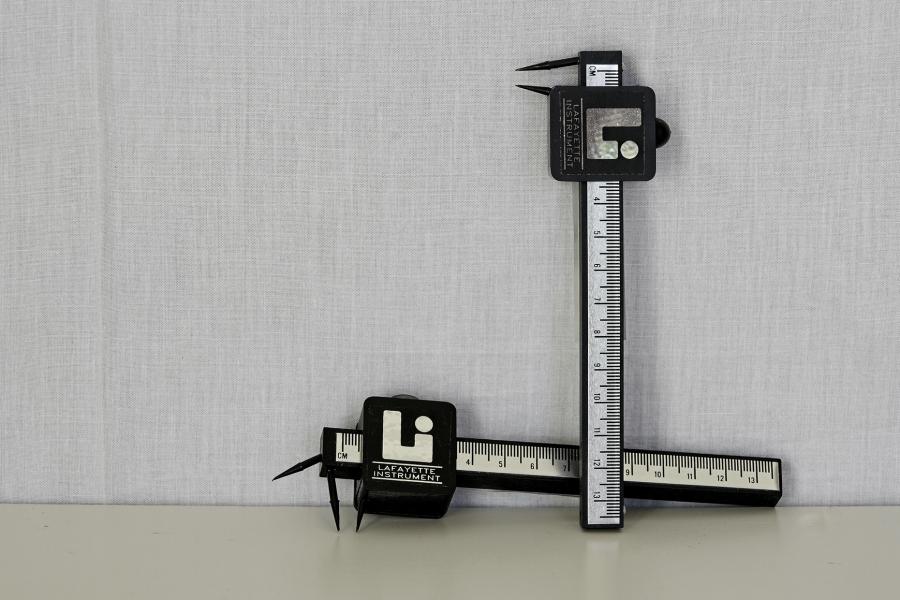
Acquired in the 80s of the 20th century.
It is used for the study of skin sensitivity. The three-pronged device allows two tactile discriminatory thresholds to be established between two points.
The fact of having three tips confers the instrument greater flexibility. The individual has to distinguish when s/he is touched, for example, on a finger, with one or two tips.
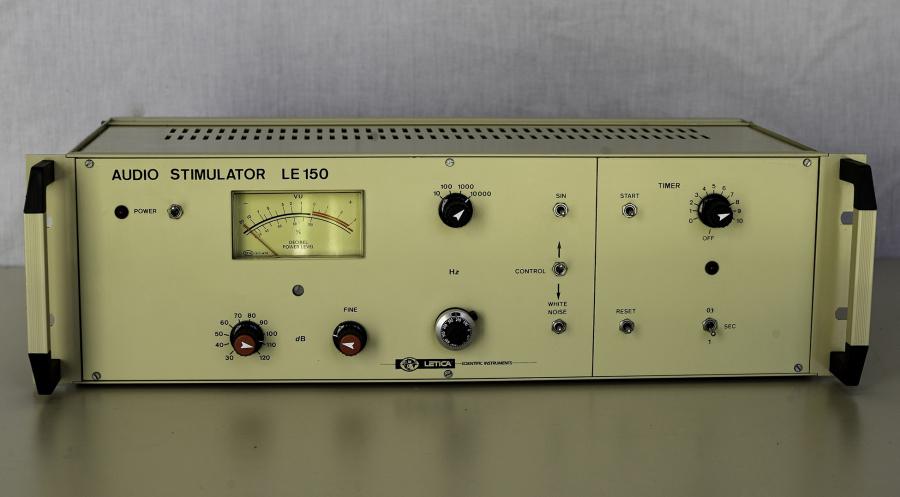
Acquired in the 80s of the 20th century.
The auditory stimulator is very useful in general basic psychology experience, both in the field of auditory perception, as well as in that of emotion, language, learning or memory.
The Letica Audio Stimulator, LE 150, allows for the presentation of auditory stimuli between 1 and 1000 Hz, 0 and 120 dB, with an adjustable duration. For its correct operation it is necessary to calibrate it using an artificial ear and a sound level meter. The sound reaches the experimental participants through headphones. Currently, this audio stimulator continues to be used, but sound activation is carried out automatically from a computer, through a purpose-designed interface via a data acquisition card.
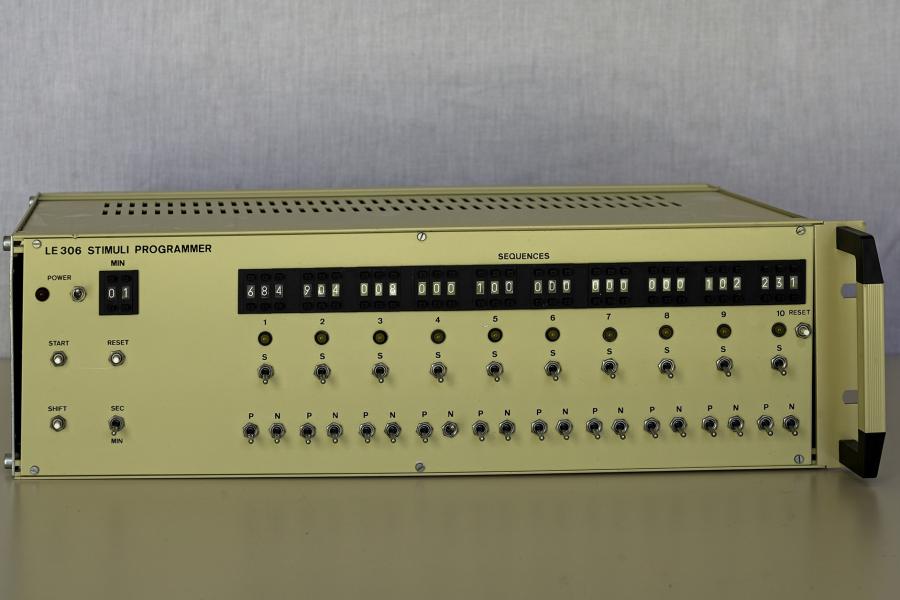
Acquired in the 90s of the 20th century.
This instrument was designed by Letica expressly for the presentation of visual stimuli. It allows controlling the exposure time of the stimuli, the light intensity, the frequency of appearance, the interval between stimuli or the sequence of their presentation. It is usually coupled to other recording devices, such as stopwatches, which measure the reaction time of participants in experiments, or presentation devices, such as televisions.
The presentation of visual stimuli is very common in basic psychology and physiology experiments that involve processes such as visual perception, attention, memory or learning.
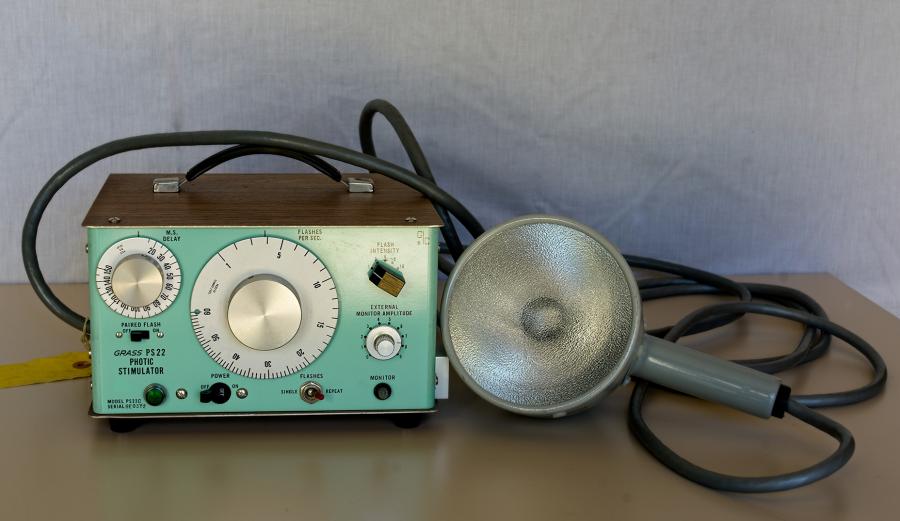
Acquired in the 90s of the 20th century.
The Model PS33-Plus Photic Flash visual stimulator is designed for photic activation of the electroencephalogram. It is used in research procedures with visual evoked potentials, electroretinogram and neuro-ophthalmology.
It has different flash intensities. The flash duration is 10 microseconds. Flashes can be simple or repetitive.
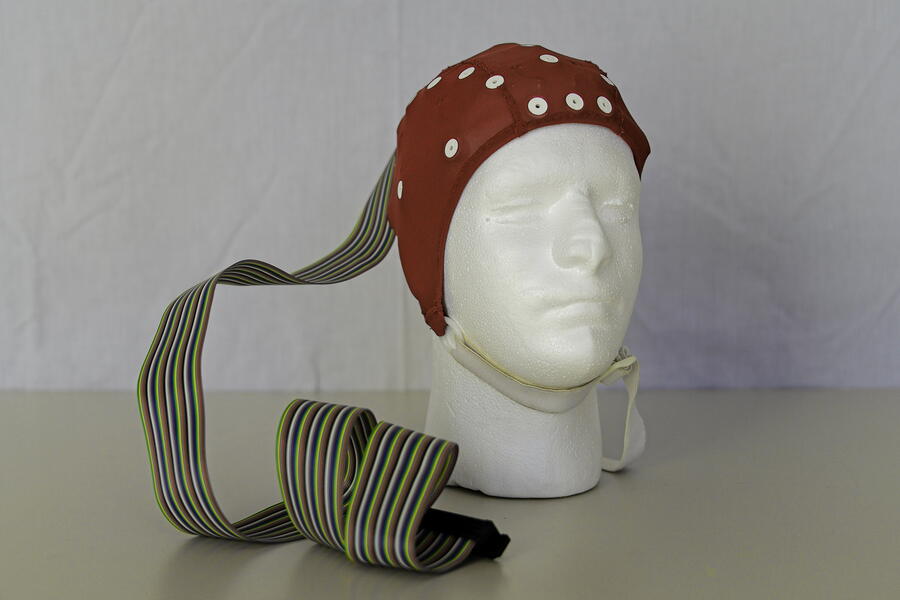
Acquired in the first years of the 21st century.
Encephalography is a non-invasive test that allows the study of brain electrical activity. It is used to study the functioning of the central nervous system, more specifically, the activity of the cerebral cortex. It consists of recording, by means of electrodes placed on the surface of the head, the postsynaptic potentials produced by brain neurons, which are the basis of the functioning of the N. S. The cables start from the cap, connected to an amplifier and this to a computer. By synchronizing the EEG recording with the presentation of stimuli and the emission of responses, it is possible to obtain Evoked Potentials, electrical activity associated with the different phases of information processing, with excellent temporal resolution.
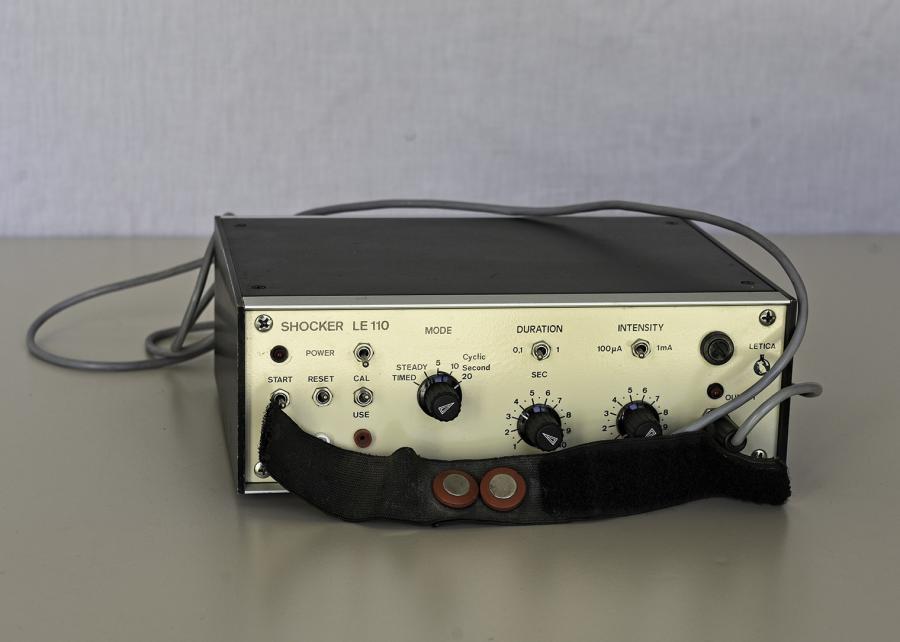
Acquired in the 80s of the 20th century.
It is used in experiments or in human classical conditioning therapies. It allows to manipulate the intensity of the discharge, which ranges between 100 µA (microampere, 10-6 A) and 1 mA (milliampere, 10-3 A) and also its duration, which ranges between 100 m and 1 s. Likewise, it allows you to design a program in which shocks are administered according to a fixed-ratio temporal pattern. It has a bipolar bracelet that is usually placed on the inside of the participant's arm, through which electric shocks are administered. This device is usually connected to a polygraph to measure the participant's electrodermal activity during the session.
The usefulness of this instrument is linked to behavioural experiments or therapies, which involve the administration of aversive stimulation, as in cases of addictions of different types, in which the administration of electric shocks is concomitant to exposure to the stimulus that causes the addiction.
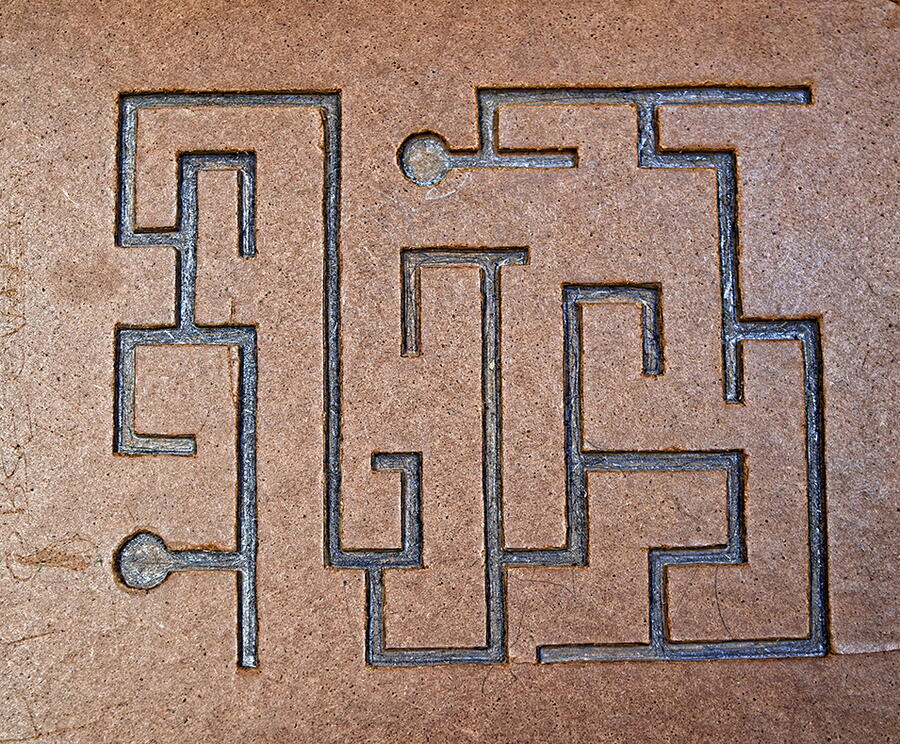
Acquired in the 80s of the 20th century.
The purpose of Foster's labyrinth is to study learning processes in humans. The person, blindfolded, has to learn the labyrinth by heart, walking through it with a stylus, from the starting point to the finish line, without making mistakes. Errors happen every time the person goes with the stylus through a dead-end path. You can count the number of errors (or trials) until you learned the route, or the time it took to learn it without making any errors.
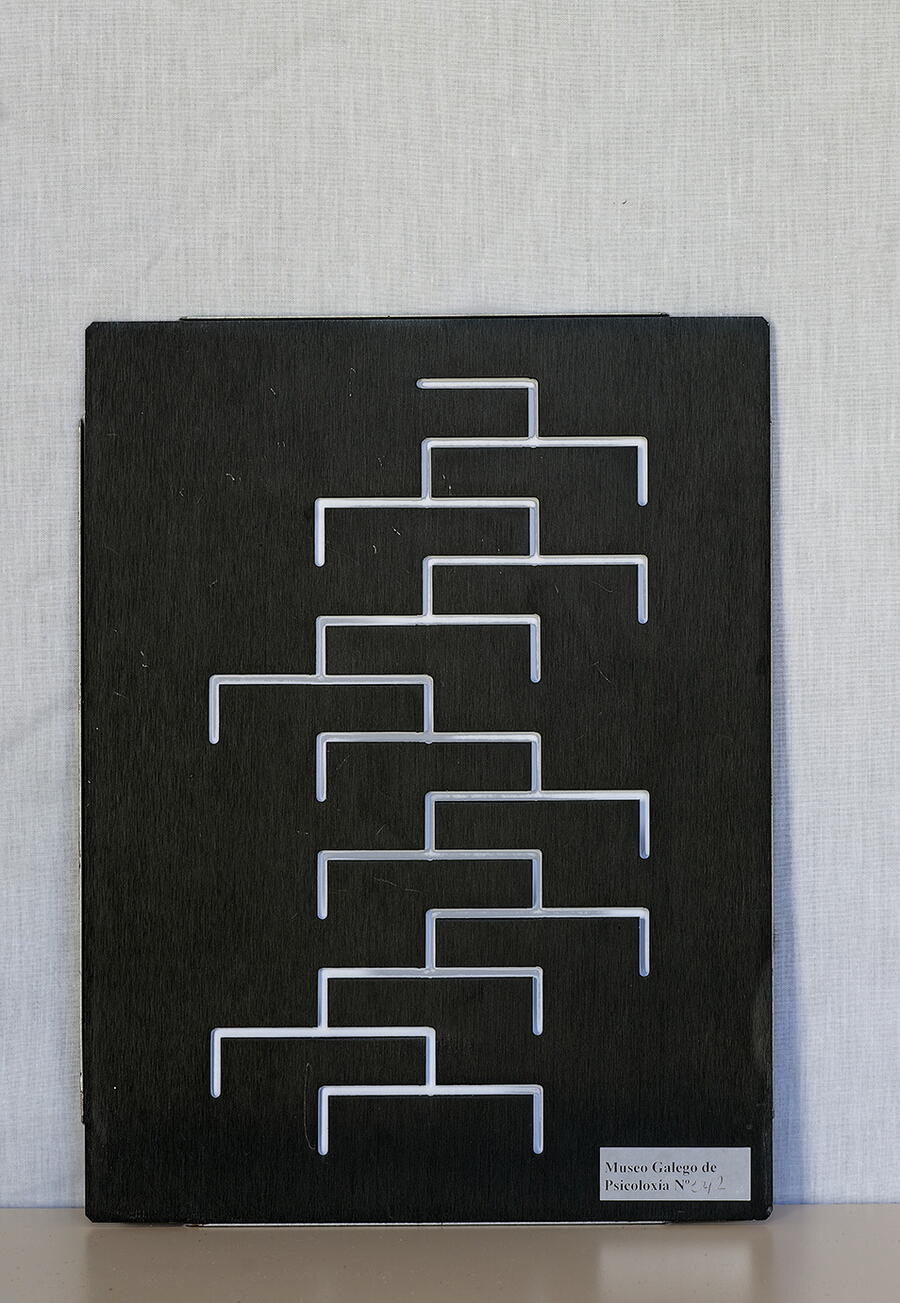
Acquired in the 80s of the 20th century.
This device consists of an aluminium plate in which a labyrinth was drilled. The possibility of inverting the labyrinth and rotating it in all directions allows you to obtain the mirror effect. The task of going through the labyrinth must be done with a stylus and blindfolded.
The device has the possibility of placing a paper under the labyrinth, which makes it possible to have a permanent record of the task performed by the subject.
The speed or precision in completing the task can be fully analysed.
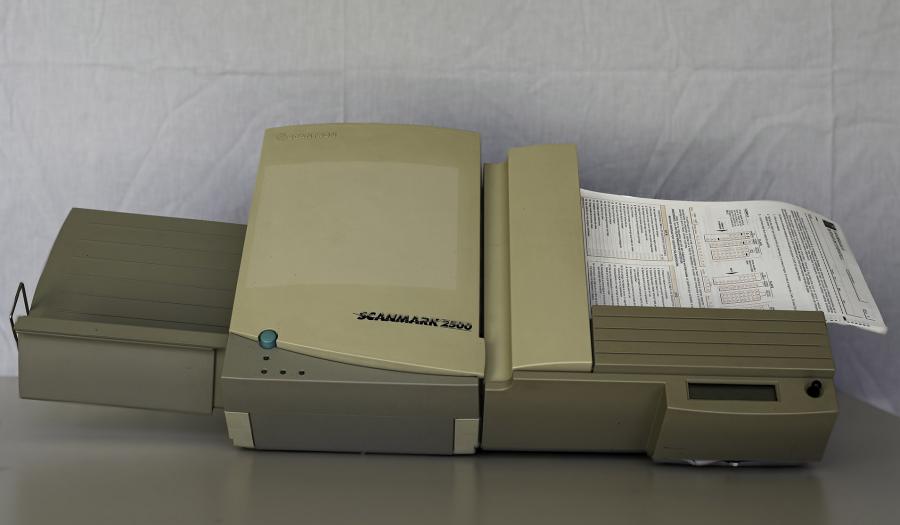
Acquired in 1997.
It is an optical mark recognition (OMR) machine. It is a device that is based on the use of a fixed scanner that detects the marks of pre-established spaces on a form, which is encoded using specific software. Prior to its appearance, devices based on the use of paper tapes or punched cards were used, in which holes in the surface were used instead of ink marks.
In modern OMR, an optical scanner is used for the detection of a small ink mark. The first successful models appeared in the early 1960s (Everett Franklin Lindquist, IBM). The model shown was manufactured by Scantron Corporation (a company founded in 1972) which popularized these machines by marketing models accessible to small institutions. This specific model was acquired by the Research Unit in Prevention and Treatment of Behaviour Problems (UDIPRE) of the USC in 1997, with Professor Mª Angeles Luengo Martín being the director of the group, within a project financed by the Ministry of Education and focused in the large-scale evaluation of the “Building Health” prevention program.
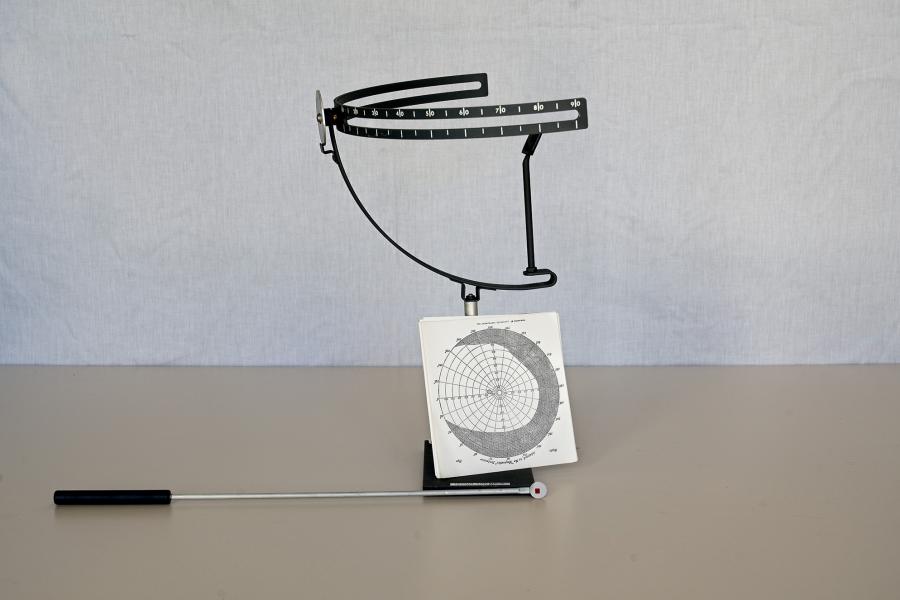
Acquired in the 80s of the 20th century.
The unit consists of an eye support, an attachment point, and a 180° graduated arc that can rotate completely around an attachment point. The unit also consists of five cards (blue, green, yellow, red and white).
It can be used to make colour maps of the sensitive area of the retina.
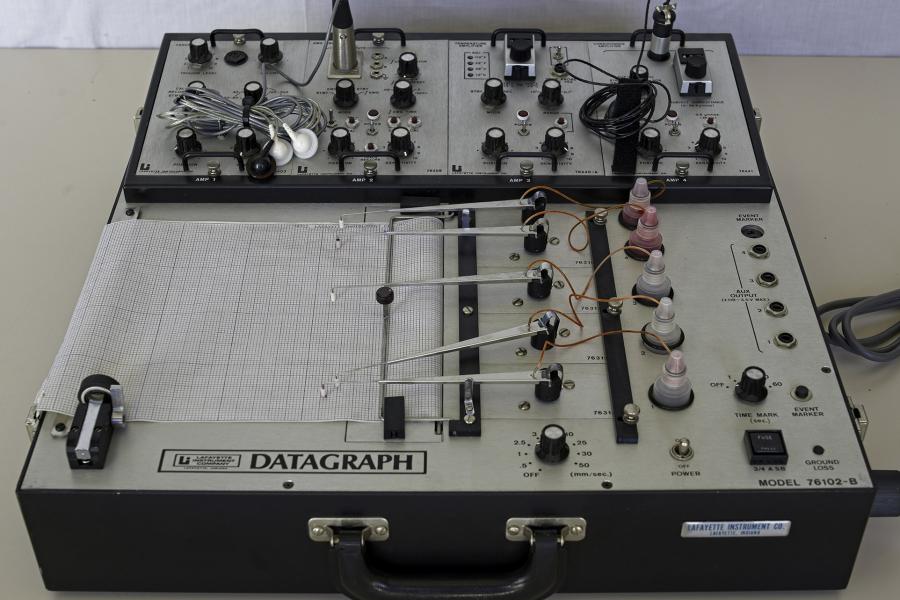
Purchased in the 1990s
This device, popularly known as a lie detector, is used to record the physiological activity of participants in psychological experiments, although it is also of interest in other areas, such as police investigation. It allows us to measure the fluctuation of the participant's physiological variables (respiratory rate, blood pressure, heart rate and galvanic skin resistance), while he or she is subjected to a series of questions to stimulate physiological responses. These responses are recorded by the sensors and printed on continuous paper that the experimenters analyse and interpret.
The use of this device is based on the theory that a person's physiological responses change in a measurable way when he or she lies. In this regard, it should be noted that the polygraph does not detect lies since it is not designed for that: it only measures the physiological responses of the organism.
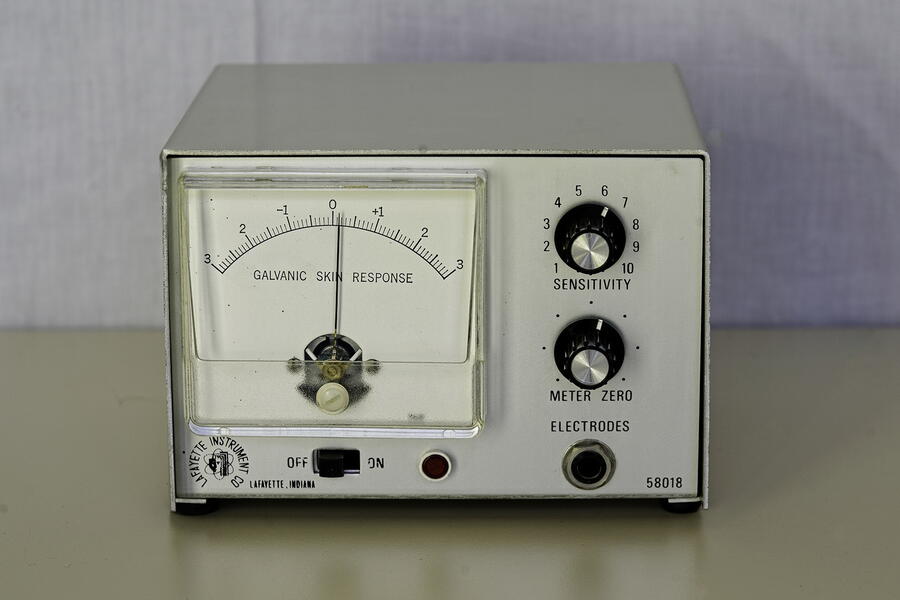
Acquired in the 1980s
This unit records psychogalvanic skin responses (PGS) through two electrodes placed on the index and ring fingers. The electrical conductivity or resistance of the skin due to certain sensory stimuli or psychic processes is measured through the oscillation of the needle.
The device is used to see the changes that occur in the electrical resistance of the skin due to psychosomatic disorders (emotion, anxiety…).
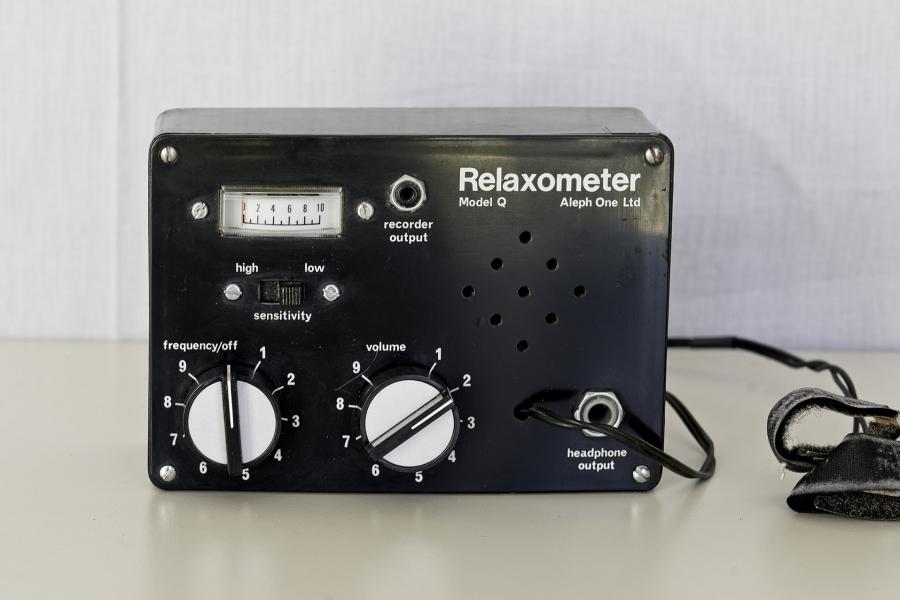
Acquired in the 1980s
This is a device that produces an auditory signal whose level varies with changes in the activity of the participant's autonomic nervous system. It has two surface electrodes that measure the electrical resistance of the subject's skin. This measurement is translated into a continuous tone provided through a sound amplifier. The subject's excitement produces a drop in the skin's resistance and an increase in the tone level. On the other hand, when the subject relaxes, the tone level drops, providing information that s/he is relaxing properly.
Since its introduction in 1971, it has been used by both clinical psychologists and researchers interested in problems such as hypnosis, the treatment of migraine or hypertension. The model Q is the most sophisticated of the entire series, as it has a counter and an output to connect to a cumulative record, which is capable of collecting all the physiological activity of the session.
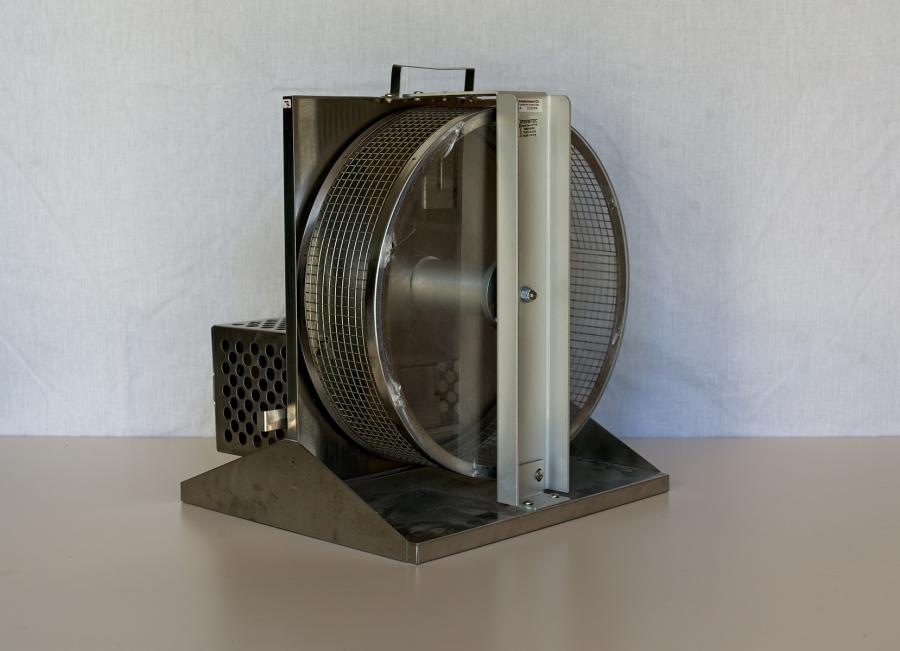
Acquired in the 1980s
The activity wheel consists of two parts: a rat cage and a running wheel. Once a rat is allowed onto the wheel, it starts running on it, while a counter counts the number of laps it makes.
It is used to study the influence of motivation (hours of food deprivation) on the activity of rats. It is also used, for example, to induce anorexia. If these rodents are put on a diet, they continue to run just as fast, until they eventually stop eating.

Acquired in the 1980s
This device allows the presentation of words to be memorized. Using a 28-line paper roll, the words appear in jumps, one by one, and can be seen through a slot.
It allows three presentation times: 1, 2 and 4 seconds. It was originally created for serial learning in humans, using the anticipation method.
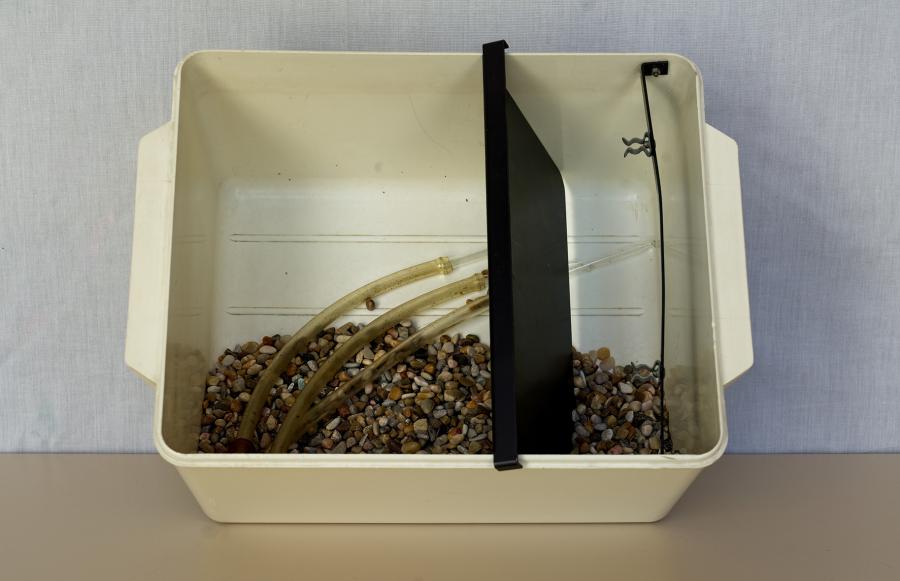
Acquired in the 1980s
This tank is specially designed to perform discrimination learning in small or medium-sized fish.
Two feeders of different colours are hung, separated from the fish by a gate. After removing the gate, the fish must know what colour the food is in order to eat it.
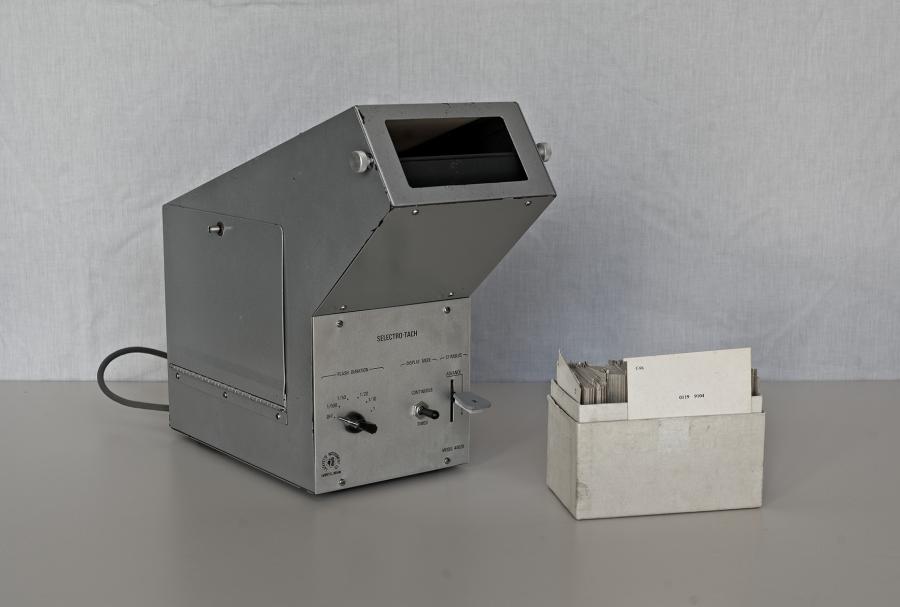
Acquired in the 1980s
This single-channel device is suitable for presenting stimuli with a controlled and precise duration. It allows the use of stimulus exposure times of: 1/100, 1/50, 1/25, 1/10 and 1 s. This particularity made it very attractive for use in the presentation of subliminal images in the 1960s for advertising purposes. Its use was mainly linked to experimentation in basic psychology, especially in the field of visual perception and memory.
Its handling is very simple since the presentation of the stimulus cards can be done automatically. It is characterized by the fact that the stimulus presentation area simulates constant lighting, thus minimizing the effects of adaptation to light and darkness, which allows the design of experiments with longer sessions.
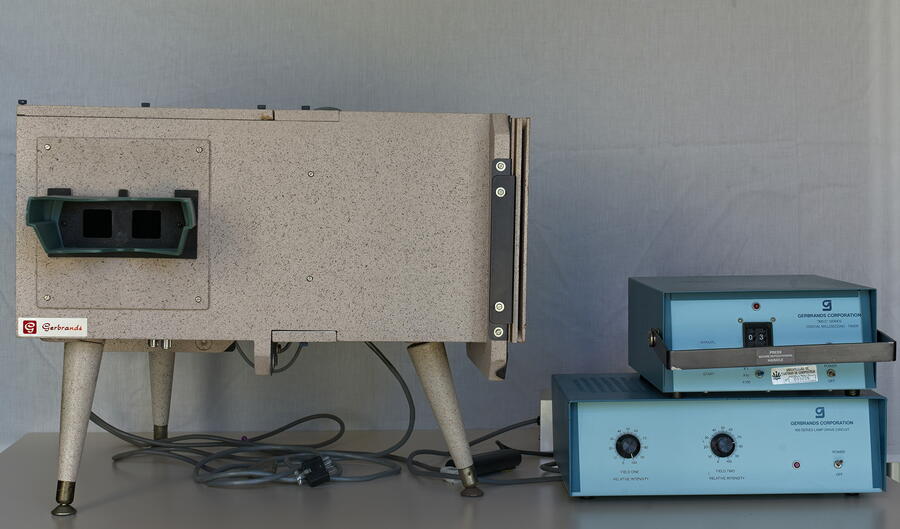
Acquired in the 1980s
The tachistoscope was designed by the German scientist Alfred Wilhelm Volkmann in 1859, although its use did not become widespread until Samuel Renshaw used it for training and selecting military pilots during World War II.
Since then, it has been widely used in basic research for the presentation of visual stimuli with programmable exposure times. It has a viewfinder through which the stimuli are presented, which, once they receive adequate lighting, are perceptible to the participants of the experiments.
This device allowed research studies to be carried out on attention, perception and memory. To record the responses, which could be vocal or mechanical, additional devices were usually fitted, such as tape recorders or chronometers that recorded the type of response and reaction time, respectively.
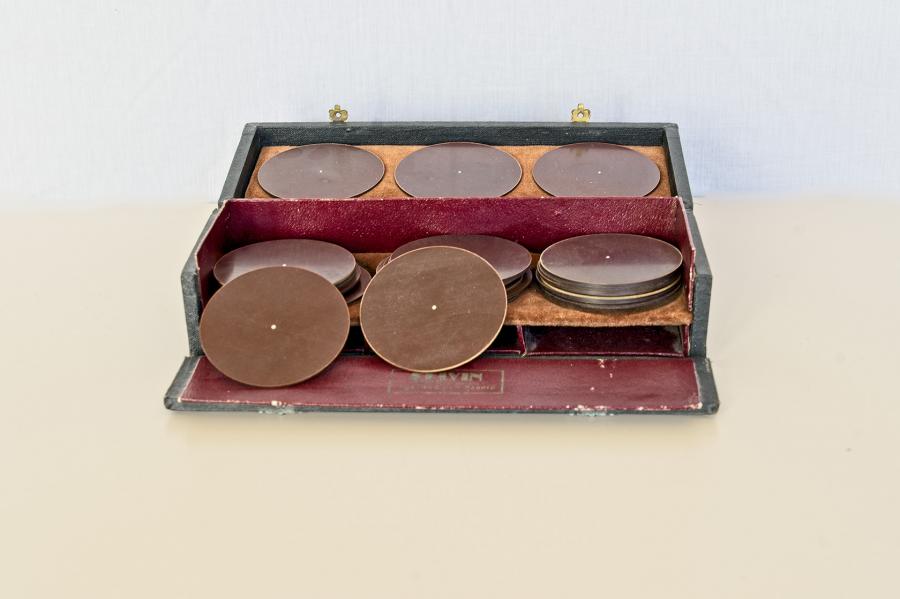
It was probably acquired in the 1930s or 1940s
This instrument consists of 33 disks of equal size and thickness, with a dot engraved in the middle of one of their faces. One third has the dot in the exact centre, another third has the dot 1 mm off centre, and the remaining have the dot 2 mm off centre. Three of the disks, one from each group, form the comparison stimulus. On the back of each disk a figure of three numbers is printed, of which the middle one indicates the group to which each one belongs.
The test consists of placing the disks according to the group to which they belong. In the final score obtained by the subjects, errors or deviations are counted (one error if they miss one step and two errors if they miss two steps). The purpose of this instrument is to explore geometric and spatial appreciation.
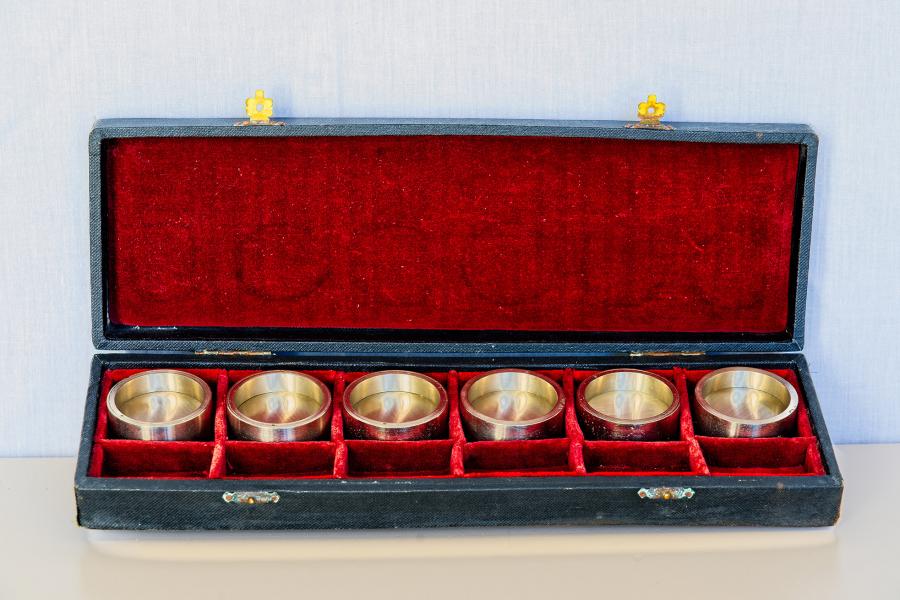
It was probably acquired in the 1930s or 1940s
The Klemm´s Thickness Test consists of six discs of the same size and shape with a cylindrical ring. They only differ in the thickness of the middle septum, which measures 0.3, 0.4, 0.6, 0.9, 1.2 or 1.8 millimetres. Each disc has a three-digit number engraved on it, the last two of which indicate its order within the scale.
The test consists of asking participants to place the discs in a graduated manner, in order from least to greatest thickness, or vice versa, for which they must hold the discs between the index finger and thumb, to estimate their thickness. The purpose of this instrument is to explore tactile sensitivity by discriminating between different thicknesses.
This test is part of classical psychophysics, which aims to study the quantitative relationships between physical stimuli and sensory responses, with a view to establishing a scale for measuring sensations.
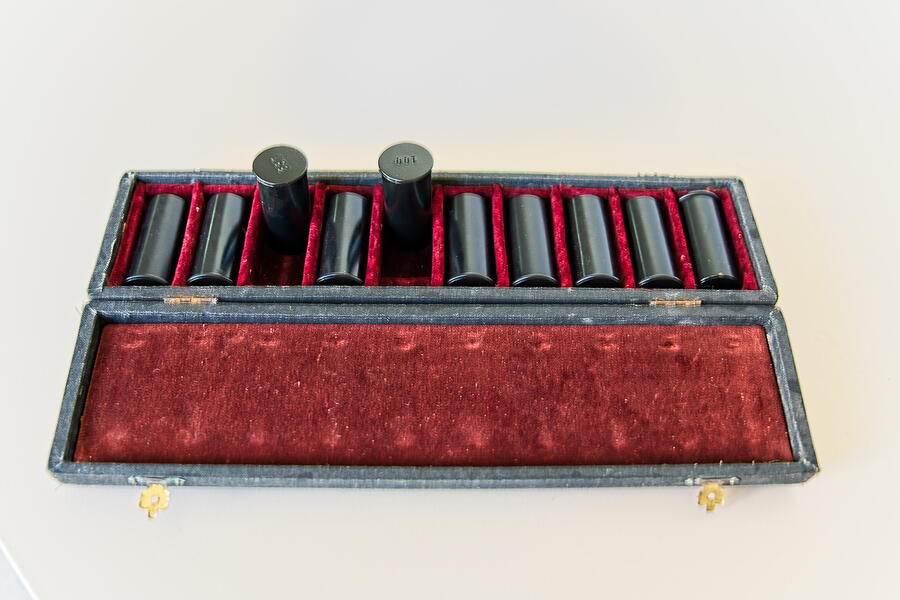
It was probably acquired in the 1930s or 1940s
This device consists of ten cylinders of equal size but different weights; the lightest is 100 g and the difference in weight between each one is 3.5 g with respect to the next or the one preceding it on the scale. Each cylinder has a three-digit number printed on its base, of which the middle one indicates the correct position of the cylinder within the scale.
The test consists of asking participants to place the cylinders in a graduated manner, in order from the smallest to the largest weight or vice versa. The purpose of this instrument is to explore weight sensitivity or weight estimation. This test is part of classical psychophysics, which aims to study the quantitative relationships between physical stimuli and sensory responses, with a view to establishing a scale for measuring sensations.
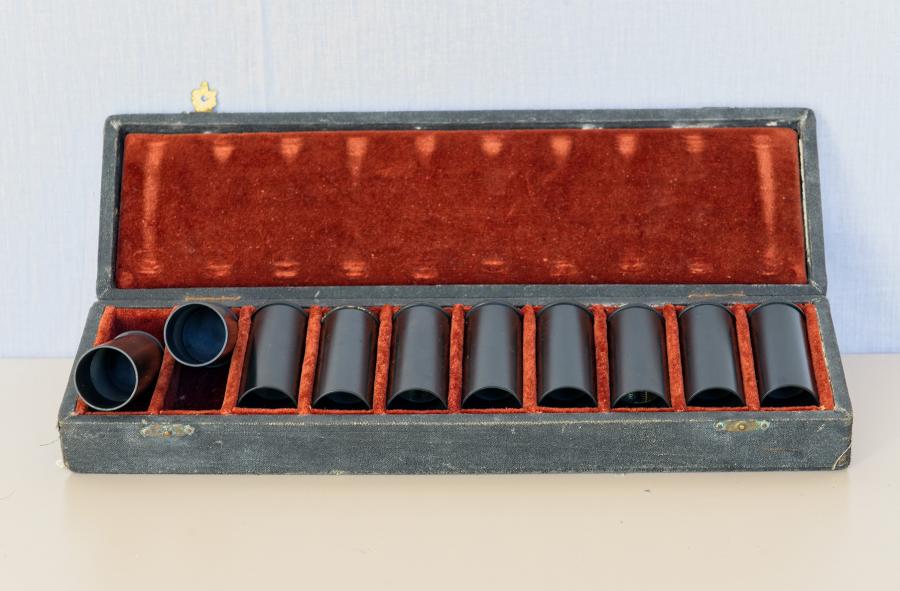
It was probably acquired in the 1930s or 1940s
This device consists of ten cylinders of equal size, open and pierced at one end and with grooves on the inside bottom varying in roughness. Each cylinder has a three-digit number on its base, of which the middle one indicates the correct position of the cylinder within the scale. Specifically, the least rough cylinder is marked with code 601, while the roughest on the scale is indicated with code 916.
The test consists of asking participants to hold the cylinder with their left hand, while they touch the inner roughness of the discs with the tip of the ring finger of their right hand to place them in order from least to greatest roughness or vice versa.
The purpose of this instrument is to explore tactile sensitivity to roughness.
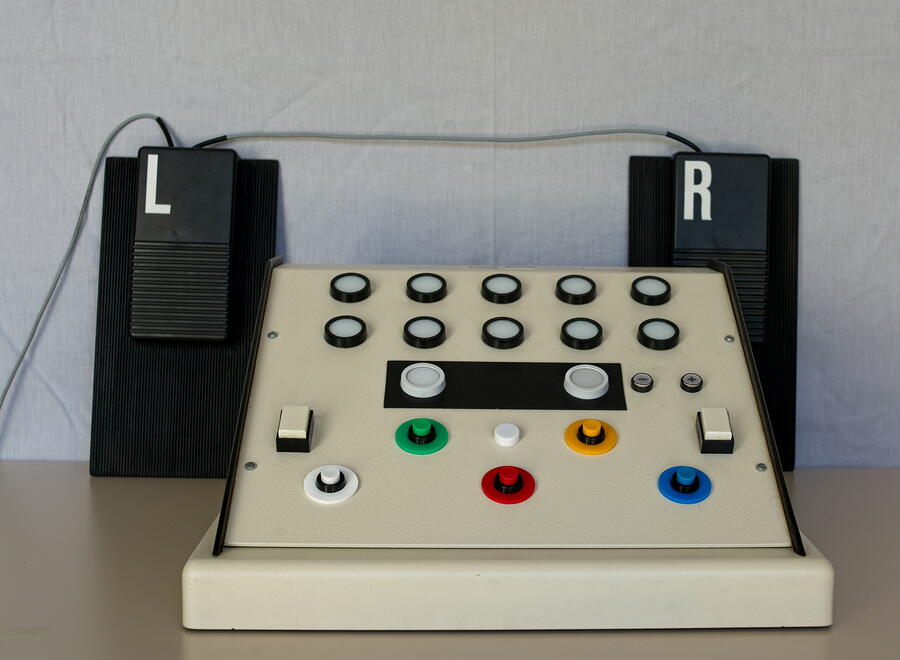
Acquired in the 1990s
It is a complex reaction unit to multiple stimuli. There are three types of stimuli: (1) visual stimuli with colours, to which the participant will respond by pressing coloured buttons; (2) visual stimuli by means of two white lights, to which the participant must respond with two pedals placed on the floor; (3) auditory, to which the participant will respond by pressing two white rectangular buttons located on the right and left ends of the console. Normally, participants must respond to the stimuli by pressing the button most similar to it (e.g., the green button will have the green light as the correct response; the left pedal will have the light on the left side of the console as the correct response). The association of stimuli and responses may be arbitrary and programmable by the experimenter. The reactions will always be carried out by pressing one single button. It allows measuring tolerance to reactive stress, attention deficits and reaction speed to rapidly changing optical and acoustic stimuli and continuous sounds.
Main areas of application: Traffic Psychology, Aptitude Diagnosis in the Field of Performance, Neuropsychology, Clinical Psychology, Medicine and Pharmacology, Sports Psychology, Motor Aptitude Diagnosis and Organizational Psychology.
